Wikipedia
This text was copied from Wikipedia on 13 April 2024 at 6:10AM.
| Christ's College | ||||||
|---|---|---|---|---|---|---|
| University of Cambridge | ||||||
 First Court, Christ's College | ||||||
 Arms of Christ's College, being the arms of the founder Lady Margaret Beaufort Arms: Royal arms of England a bordure componée azure and argent | ||||||
| Scarf colours: brown, with two equally-spaced narrow white stripes
| ||||||
| Location | St Andrew's Street (map) | |||||
| Coordinates | 52°12′23″N 0°07′21″E / 52.2063°N 0.1224°E / 52.2063; 0.1224 | |||||
| Abbreviation | CHR[1] | |||||
| Motto | Souvent me Souvient (Old French) | |||||
| Motto in English | I often remember / Remember me often[2] | |||||
| Founders |
| |||||
| Established | 1437 (1437) (refounded 1505) | |||||
| Named after | Jesus Christ | |||||
| Previous names | God's House (1437–1505) | |||||
| Sister colleges | ||||||
| Master | Simon McDonald | |||||
| Undergraduates | 459 (2022-23) | |||||
| Postgraduates | 265 (2022-23) | |||||
| Endowment | £107m (2019)[4] | |||||
| Visitor | Chancellors of the University ex officio[5] | |||||
| Website | www.christs.cam.ac.uk | |||||
| JCR | www.thejcr.co.uk | |||||
| MCR | www.christsmcr.co.uk | |||||
| Boat club | christsbc.soc.srcf.net | |||||
| Map | ||||||
Christ's College is a constituent college of the University of Cambridge.[6] The college includes the Master, the Fellows of the College, and about 450 undergraduate and 250 graduate students.[7] The college was founded by William Byngham in 1437 as God's House. In 1505, the college was granted a new royal charter, was given a substantial endowment by Lady Margaret Beaufort, and changed its name to Christ's College, becoming the twelfth of the Cambridge colleges to be founded in its current form. Alumni of the college include some of Cambridge University's most famous members, including Charles Darwin and John Milton.
The current Master is Lord McDonald of Salford.[8]
History

Christ's College was founded by William Byngham in 1437 as God's House,[9] on land which was soon after sold to enable the enlargement of King's College.[10] Byngham obtained the first royal licence for God's House in July 1439.[11] The college was founded to provide for the lack of grammar-school masters in England at the time,[12] and the college has been described as "the first secondary-school training college on record".[13] The original site of Godshouse was surrendered in 1443 to King's College, and currently about three-quarters of King's College Chapel stands on the original site of God's House.[14]
After the original royal licence of 1439, three more licences, two in 1442 and one in 1446, were granted before in 1448 God's House received the charter upon which the college was in fact founded.[15] In this charter, King Henry VI was named as the founder, and in the same year the college moved to its current site.[16]
In 1505, the college was endowed by Lady Margaret Beaufort, mother of King Henry VII, and was given the name Christ's College, perhaps at the suggestion of her confessor, the Bishop John Fisher.[17] The expansion in the population of the college in the seventeenth century led to the building, in the 1640s, of the Fellows' Building in what is now Second Court.[17]
Buildings
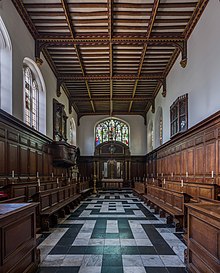
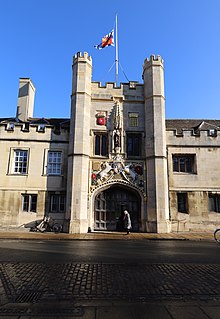
The original 15th/16th century college buildings now form part of First Court, including the chapel, Master's Lodge and Great Gate tower. The gate itself is disproportionate: the bottom has been cut off to accommodate a rise in street level, which can be seen in the steps leading down to the foot of L staircase in the gate tower. The college hall, originally built at the very start of the 16th century, was restored in 1875–1879 by George Gilbert Scott the younger. The lawn of First Court is famously round, and a wisteria sprawls up the front of the Master's lodge.
Second Court is fully built up on only three sides, one of which is formed by the 1640s Fellows' Building. The fourth side backs onto the Master's garden.
The Stevenson Building in Third Court was designed by J. J. Stevenson in the 1880s and was extended in 1905 as part of the College's Quadcentenary. In 1947 Professor Albert Richardson designed a new cupola for the Stevenson building, and a second building, the neo-Georgian Chancellor's Building (W staircase, now known as The Blyth Building), completed in 1950. Third Court's Memorial Building (Y staircase), a twin of the Chancellor's building, also by Richardson, was completed in 1953 at a cost of £80,000.[18] Third Court is also noted for its display of irises in May and June, a gift to the college in 1946.[19]
The controversial tiered concrete New Court (often dubbed "the Typewriter") was designed in the Modernist style by Sir Denys Lasdun in 1966–70, and was described as "superb" in Lasdun's obituary in the Guardian.[20] Design critic Hugh Pearman comments "Lasdun had big trouble relating to the street at the overhanging rear".[21] It appears very distinctively in aerial photographs, forming part of the northern boundary of the college.
An assortment of neighbouring buildings have been absorbed into the college, of which the most notable is the Todd Building, previously Cambridge's County Hall.[22]
Through an arch in the Fellows' Building is the Fellows' Garden. It includes two mulberry trees, of which the older was planted in 1608, the same year as Milton's birth. Both trees have toppled sideways, the younger tree in the Great Storm of 1987, and are now earthed up round the trunks, but continue to fruit every year.[23]
Swimming pool
Christ's College is one of only 5 colleges in Oxford or Cambridge to have its own swimming pool. It is fed by water from Hobson's Conduit. Recently refurbished, it is now known as the 'Malcolm Bowie Bathing Pool', and is thought to be the oldest outdoor swimming pool in the UK, dating from the mid 17th century.[24] The other four swimming pools within colleges belong to Girton College (indoor pool), Corpus Christi College (outdoor pool), Emmanuel College (outdoor pool) and Clare Hall (indoor pool).
Gallery
-
Master's Lodge, First Court
-
Charles Darwin's Rooms, First Court
-
Christ's College Cambridge, Dining Hall, Back
-
Fellows' Garden, showing rear of Fellows' Building
-
Third Court: Memorial and Stevenson Buildings
-
New Court: Lasdun Building, known as "The Typewriter"
-
Darwin Garden, New Court, w. Darwin statue by Anthony Smith
Plan of College
Christ's College, Cambridge, from above in 2009
| |||||||||||||||||||||||||||||||||||
Academic profile
With a deserved reputation even within Cambridge for the highest academic standards, Christ's came first in the Tompkins Table's twentieth anniversary aggregate table,[25] and between 2001 and 2007, it had a mean position of third.[26] Academic excellence continues at Christ's, with 91% of students in 2013 gaining a first class degree or an upper second (II.i). This is significantly higher than the University average of 70%.[27][28]
Christ's is noted for educating two of Cambridge's most famous alumni, the poet John Milton and the naturalist Charles Darwin, who, during the celebrations for the 800th anniversary of the University, were both placed at the foreground as two of the four most iconic individuals in the University's history.[29][30][31] The college has also educated Nobel Laureates including Martin Evans, James Meade, Alexander R. Todd, Baron Todd and Duncan Haldane.[32][33] It is the University's 6th largest producer of Nobel Prize winners.
Some of the college's other famous alumni include former archbishop of Canterbury Rowan Williams, theologian William Paley, historian Simon Schama, South African Prime Minister Jan Smuts, Lord Louis Mountbatten of Burma, medical doctor, scientist, and diplomat Davidson Nicol, and comedians John Oliver, Sacha Baron Cohen, and Andy Parsons.
Student life
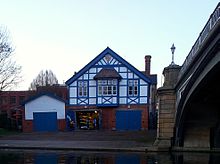
The Junior Combination Room (JCR), represents the undergraduate students. It organises social and welfare events, and negotiates on the students' behalf on important issues. The JCR has a standing committee and a common room for all the students. The JCR's counterpart, the Middle Combination Room (MCR) represents the graduate students of the College, and has its own bar. The MCR organises regular Graduate Halls. A Garden Party is held by both the JCR and the MCR every June in the Fellows' Garden. The Senior Combination Room (SCR) is composed solely of fellows of the College and holds two feasts each year.
The Acting Chaplain of the college is Michael Dormandy.
Other societies in Christ's include:
- The Marguerites Club, one of the oldest surviving College societies, reformed in 1899 by Gilbert Jessop the then captain of CUCC. It is believed to have originally formed some ten years earlier, but was soon disbanded. Originally the society was confined to captains and secretaries or those with colours in three sports. Nowadays it is also known as a drinking society, as well as a club recognising sporting excellence. The name originated from the club's original blazer, which was navy blue in colour with the Foundress's 'rebus' or badge, signifying her name, embroidered on the pocket.
- Christ's College Boat Club, the oldest college sports club still active, having been founded in 1830. Like many other Cambridge Colleges, Christ's has its own boathouse on the banks of the Cam.
- Christ's College Rugby Football Club, founded in 1875 by Alfred Cort Haddon,[34] who is considered the father of modern anthropology. In the 1960 Varsity Match, eight of the starting Cambridge team were students at Christ's and all of the side's points were scored by Christ's players.[35] The CCRFC is nicknamed "The Brown Rings" after the brown and white hoops featured on the match kit.
- Christ's College Association Football Club, which prides itself on having won the inter-collegiate Cuppers competition more times than any other.
- Christ's Films, which uses the theatre to screen new films weekly
- Christ's Amateur Dramatic Society
- Christ's College Medical Society
- Christ's Politics Society
- Christ's College Music Society, founded 1710.
- Christ's College Chapel Choir
May Ball
Christ's, like most other Cambridge Colleges, also hosts a biennial May Ball in the time after undergraduate examinations which is by students commonly known as May Week. A separate society called "Christ's College May Ball Committee" is set up every two years to organise and direct this event. The 2010 May Ball, named "L'Esprit Nouveau", was held on 15 June 2010 and featured a 1920s Parisian theme, Two Door Cinema Club headlined the entertainment. The May Ball in June 2012 featured a Rio de Janeiro carnival theme. Other previous themes include Le Reve in 2002, Silhouette in 2004, Elysium in 2006 and 'The Jasmine Ball' in 2008.
The May Ball on Tuesday 17 June 2014 was hailed as one of the best May Balls of the year, coming close to perfection.[36] It was themed "The Emerald City".
The May Ball on Tuesday 14 June 2016 was themed as Biophilia.[37] In 2018 the theme was A Night's Tale.[38] While the 2020 Ball was cancelled due to the COVID-19 Pandemic, the May Ball returned in 2022, themed as Mythos.
The 2024 May Ball will be held on 18 June 2024, themed after the William Shakespeare play, A Midsummer Night's Dream. [39]
Grace
The College Grace is normally said before any dinner held in the Formal Hall of the College. Though the student body rises for the recitation of the Grace, Christ's is one of the only Colleges in Cambridge where the students do not rise when the Fellows enter and leave the Dining Hall. This is said to be the result of a historical conflict between the Students and Fellows at Christ's, who were on opposite sides during the English Civil War. The words of the Grace are as follows:
| Latin | English |
|---|---|
| Exhilarator omnium Christe
Sine quo nihil suave, nihil jucundum est: Per te Dominum nostrum, Amen. |
Christ, the gladdener of all,
Without whom nothing is sweet, nothing pleasant: Through you, our Lord, Amen. |
Notable people
Proctors of God's House
- 1439–1451 William Byngham
- 1451–1458 John Hurt
- 1458–1464 William Fallan
- 1464–1477 William Basset
- 1477–1490 Ralph Barton
- 1490–1505 John Sickling
Masters of Christ's
Notable alumni
| Name | Birth | Death | Career |
|---|---|---|---|
| Prince Ra'ad bin Zeid Al-Hussein | 1936 | Jordanian Prince | |
| Prince Zeid Ra'ad Zeid Al-Hussein | 1964 | UN High Commissioner for Human Rights | |
| William Ames | 1576 | 1633 | Reformed Theologian |
| Thomas Baines | 1622 | 1680 | Physician, original Fellow of Royal Society |
| Richard Bancroft | 1544 | 1610 | Archbishop of Canterbury, Organiser of James I Bible |
| Jasmine Birtles | 1962 | British financial and business commentator, television presenter, author and journalist | |
| Jagdish Chandra Bose | 1858 | 1937 | Indian physicist |
| C. Delisle Burns | 1879 | 1942 | Atheist and secularist writer and lecturer |
| Brian Cantor | 1948 | Vice-Chancellor of the University of Bradford and previously Vice-Chancellor of the University of York | |
| Sir Anthony Caro | 1924 | 2013 | Sculptor |
| Randolph Carter | 1874 | 1932 | Explorer |
| Sacha Baron Cohen | 1971 | Comedian | |
| John Cook | 1918 | 1984 | Prolific Anglo-American composer and organist |
| Miles Corbet | 1594/5 | 1662 | Regicide |
| Frederick Cornwallis | 1713 | 1783 | Archbishop of Canterbury |
| John Cornwell | 1940 | British author and journalist | |
| John James Cowperthwaite | 1916 | 2006 | Credited with policies allowing Hong Kong's economic boom in the 1960s |
| John Cridland | 1961 | Director-General of the Confederation of British Industry | |
| Charles Darwin | 1809 | 1882 | British naturalist |
| Patrick Arthur Devlin, Baron Devlin | 1905 | 1992 | Jurist, Lord of Appeal in Ordinary |
| Colin Dexter | 1930 | 2017 | Novelist |
| Jill Duff | 1972 | Bishop of Lancaster | |
| George Dwyer | 1908 | 1987 | Archbishop of Birmingham; Council Father of the Second Vatican Council |
| James Chuter Ede | 1882 | 1965 | Home Secretary and Leader of the House of Commons |
| Sir Martin Evans | 1941 | Biochemist, Nobel laureate in medicine | |
| Dee Ferris | 1973 | British Painter | |
| John Finch | 1626 | 1682 | Ambassador, original Fellow of Royal Society |
| Noel Gay | 1898 | 1954 | Composer |
| Nina Gold | 1964 | BAFTA-winning casting director | |
| Edmund Grindal | 1519 | 1583 | Archbishop of Canterbury |
| Alfred Cort Haddon | 1855 | 1940 | Father of modern anthropology |
| Duncan Haldane | 1951 | Physicist, Nobel laureate in physics | |
| Yusuf Hamied | 1936 | Chemist and industrialist | |
| Natalie Haynes | 1974 | Writer and broadcaster and a former comedian. | |
| John Healey | 1960 | British politician | |
| Derry Irvine, Baron Irvine of Lairg | 1940 | Lord Chancellor | |
| Phillip King | 1934 | 2021 | Sculptor |
| David Knowles | 1896 | 1974 | Historian |
| David Konstant | 1930 | Roman Catholic Bishop of Leeds | |
| John Kotelawala | 1897 | 1980 | Prime Minister of Ceylon (Sri Lanka) |
| John Leland | c 1506 | 1552 | Father of English history |
| Tony Lewis | 1938 | England and Glamorgan cricket captain; writer and broadcaster | |
| Michael Liebreich | 1963 | Clean energy expert, founder of Bloomberg New Energy Finance | |
| Richard Luce | 1936 | Lord Chamberlain | |
| Michael Lynch | 1965 | Founder of Autonomy Systems | |
| Edward Petronell Manby | 1864 | 1929 | Medical Officer to the Ministry of Health |
| Allama Mashriqi | 1883 | 1963 | Founder of the Khaksar Tehreek |
| Sir Peter Mathieson | 1959 | Vice-Chancellor of the University of Edinburgh | |
| David Mellor | 1949 | British politician | |
| Sir Walter Mildmay | 1589 | Founder of Emmanuel College, Cambridge | |
| Miles Millar | c 1967 | Hollywood screenwriter and producer | |
| John Milton | 1608 | 1674 | English poet |
| Helen Mort | 1985 | Poet | |
| Louis Mountbatten, 1st Earl Mountbatten of Burma | 1900 | 1979 | British Admiral of the Fleet and statesman |
| Thomas Nelson, Jr. | 1738 | 1789 | Governor of Virginia; signer of the American Declaration of Independence |
| Davidson Nicol | 1924 | 1994 | Sierra Leonean academic, diplomat, physician, and writer |
| John Oliver | 1977 | British political comedian | |
| J. Robert Oppenheimer | 1904 | 1967 | American theoretical physicist and 'father of the atomic bomb' |
| Andy Parsons | 1967 | English comedian and writer | |
| William Paley | 1743 | 1805 | English theologian and philosopher |
| Steve Palmer | 1968 | Professional football player | |
| John Peile | 1838 | 1910 | Philologist |
| William Perkins | 1558 | 1602 | Leading Puritan Theologian of the Elizabethan Era |
| Sir John Plumb | 1911 | 2001 | British historian |
| Thomas Plume | 1630 | 1704 | English clergyman, founder of the University's Plumian Chair of Astronomy and Experimental Philosophy |
| Roy Porter | 1946 | 2002 | British historian |
| Beilby Porteus | 1731 | 1809 | Bishop of Chester and Bishop of London, leading reformer and abolitionist |
| Maheshi Ramasamy | Physician and lecturer | ||
| Peter Rawlinson, Baron Rawlinson of Ewell | 1919 | 2006 | Attorney General for England and Wales |
| Forrest Reid | 1875 | 1948 | Cambridge apostle, novelist, literary critic |
| Austin Robinson | 1897 | 1993 | British Economist and economic historian |
| Thomas Robinson, 2nd Baron Grantham | 1738 | 1786 | British Foreign Secretary |
| David Say | 1939 | 2006 | Bishop of Rochester |
| Simon Schama | 1945 | British historian, author, and television presenter | |
| Sir Nicholas Serota | 1946 | Director of the Tate Gallery | |
| Walter William Skeat | 1835 | 1912 | Philologist |
| Jan Smuts | 1870 | 1950 | Prime Minister of South Africa, Field Marshal, and Commonwealth statesman |
| C. P. Snow, Baron Snow | 1905 | 1980 | British novelist and philosopher |
| John Soothill | 1925 | 2004 | Paediatric immunologist |
| F. Gordon A. Stone | 1925 | 2011 | British chemist |
| Szeming Sze | 1908 | 1998 | Chinese Diplomat, WHO co-founder |
| Nicholas Tarling | 1931 | 2017 | Historian |
| Sir Jeffrey Tate | 1943 | 2017 | Conductor |
| John Tayloe III | 1770 | 1828 | Plantation owner, horse breeder and American politician. Imported Diomed to the United States |
| Henry Teonge | 1620 | 1690 | Naval chaplain and diarist |
| Andrew Turnbull, Baron Turnbull | 1945 | Cabinet Secretary and head of the Civil Service | |
| Edward Whitehead Reid | 1883 | 1930 | Aviator |
| Richard Whiteley | 1943 | 2005 | British television presenter |
| Rowan Williams | 1950 | British theologian, Anglican Archbishop of Canterbury, Master of Magdalene College, Cambridge | |
| Sir Christopher Zeeman | 1925 | 2016 | British mathematician |
References
- ^ "Notice by the Editor". Cambridge University Reporter. 149 (Special No 5). University of Cambridge: 1. 6 March 2019. Retrieved 20 March 2019.
- ^ "Introducing 'Souvient' – a new Cambridge podcast series inspired by Lady Margaret Beaufort". St John's College, Cambridge.
- ^ "Fellows' Guide to Christ's College". Christ's College. Retrieved 8 October 2015.
- ^ Christ's College RCCA 2018–19 Archived 24 September 2021 at the Wayback Machine
- ^ Christ's College, Cambridge (June 2022). "Statutes and Ordinances" (PDF). christs.cam.ac.uk. Archived (PDF) from the original on 20 October 2022. Retrieved 20 October 2022.
- ^ "Homepage | Christs College Cambridge". www.christs.cam.ac.uk. Retrieved 1 November 2022.
- ^ "Undergraduate Admissions: Christ's College". University of Cambridge website. Retrieved 2 August 2009.
- ^ "Christ's College Welcomes New Master | Christs College Cambridge". www.christs.cam.ac.uk. Retrieved 2 September 2022.
- ^ "History | Christs College Cambridge". www.christs.cam.ac.uk. Retrieved 1 November 2022.
- ^ Lloyd, A.H. The Early History of Christ's College. p. 13.
- ^ Lloyd, A.H. The Early History of Christ's College. p. 24.
- ^ Lloyd, A.H. The Early History of Christ's College. p. 37.
- ^ Leach. The Schools of Medieval England. p. 257.
- ^ Lloyd, A.H. The Early History of Christ's College. pp. 44–45.
- ^ Lloyd, A.H. The Early History of Christ's College. p. 86.
- ^ Lloyd, A.H. The Early History of Christ's College. p. 73.
- ^ a b "College History". Christ's College, Cambridge. Retrieved 6 October 2015.
- ^ Christ's College Magazine, Michaelmas 1953
- ^ Christ's College Magazine no. 228, p 53, 2003
- ^ "Architects pay tribute to Denys Lasdun". The Guardian. 12 January 2001. Retrieved 13 September 2014.
- ^ "The Legacy of Lasdun". Archived from the original on 5 March 2012.
- ^ Pevsner, Nikolaus (1970). The Buildings of England: Cambridgeshire. London: Penguin. p. 232. ISBN 978-0300205961.
- ^ Christ's College Magazine no. 228, p 56, 2003
- ^ "Malcolm Bowie Bathing Pool Official Opening". Christ's College, Cambridge. Archived from the original on 25 May 2014. Retrieved 13 September 2014.
- ^ Judd, Judith (24 July 2000). "Christ's top of 20-year table of Cambridge colleges". The Independent. Archived from the original on 22 January 2014. Retrieved 13 September 2014.
- ^ "Tompkins Table 2000-2007". Matt Mayer. Archived from the original on 1 August 2009. Retrieved 8 October 2015.
- ^ Partington, Richard (2011). "Identifying and supporting Cambridge applicants" (PDF). University of Cambridge. Archived from the original (PDF) on 22 May 2014. Retrieved 13 September 2014.
- ^ "Christ's College Annual Magazine 2013". Christ's College, Cambridge Alumni. Archived from the original on 22 May 2014. Retrieved 13 September 2014.
- ^ "Quentin Blake unveils Cambridge 800 panorama". University of Cambridge. 28 September 2009. Retrieved 10 July 2014.
- ^ University education (18 January 2009). "Cambridge University's 800th birthday celebrated with spectacular light show". The Daily Telegraph. Archived from the original on 12 January 2022. Retrieved 10 July 2014.
- ^ "University's history writ large on screen | Cambridge City News, Cambridge Local News Stories & Latest Headlines". Cambridge News. Archived from the original on 24 December 2013. Retrieved 10 July 2014.
- ^ "University of Cambridge Nobel Laureates". Retrieved 8 October 2015.
- ^ "Christ's College Distinguished Members". Christ's College. Archived from the original on 23 October 2015. Retrieved 8 October 2015.
- ^ "Official Christ's College Website; Distinguished Alumni". Christ's College, Cambridge. Archived from the original on 18 January 2013. Retrieved 13 September 2014.
- ^ "Rugby Varsity Match 1960: First Half Highlights". Archived from the original on 17 November 2021. Retrieved 13 September 2014 – via YouTube.
- ^ "Christ's May Ball 2014: Close to Perfection". Archived from the original on 14 July 2014. Retrieved 19 June 2014.
- ^ "May Ball Review: Christ's".
- ^ "Review: Christ's May Ball". 21 June 2018.
- ^ "Review: Christ's May Ball". 25 February 2024.
Bibliography
- Lloyd, A. H. (2010), The Early History of Christ's College, Cambridge: Derived from Contemporary Documents, Cambridge University Press, ISBN 978-1108008976 (account of the history of God's House, originally published in 1934)
- Peile, John (2014), Biographical Register of Christ's College, 1505-1905: And of the Earlier Foundation, God's House, 1448-1505 (reprint ed.), Cambridge University Press, ISBN 978-1107426047
External links

- Official Christ's College website
- Christ's JCR website Archived 30 January 2008 at the Wayback Machine
- Christ's MCR website
- Christ's biennial May Ball Archived 23 March 2006 at the Wayback Machine
- Exhibition celebrating 400 years since the birth of John Milton
- Cambridge 2000 — Christ's College photographs



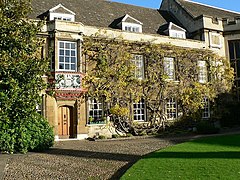
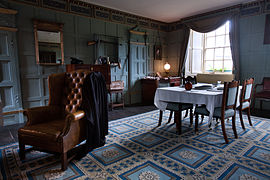


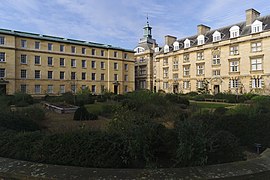

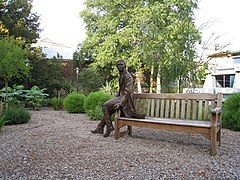








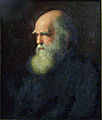










1 Annotation
Second Reading
San Diego Sarah • Link
Cosmo, the future Grand Duke of Turin, visited Cambridge on May 1/10, 1669. He mentions Christ;s College, but I don't think he visited.
I've standardized names, scanning errors I could figure out, and increased the number of paragraphs:
243
Christ's College, by the munificence of Margaret, Countess of Richmond, daughter and heiress of John Beaufort, Earl of Somerset, and widow of Edmund Hadham, Earl of Richmond, was founded in the year 1505, on the same spot where King Henry VI erected the hospital called the House of God.
This college was formed by the union of 4 buildings, with the gardens attached to them, which belonged to the monastery of Tilsey and to the priory of Denney; and although it was at that time provided with a rich endowment, this was nevertheless augmented by King Edward VI, by Dr. Thompson, by Sir Walter Mildmay, chancellor and treasurer of the Exchequer, by Edward Grindall, Archbishop of Canterbury, and by Anthony Watson, Bishop of Chichester; so that it now maintains 14 fellows and 55 scholars, with officers and servants, amounting in all to 206.
The prefect is Dr. Cudworth, theologian, who enjoys, in conjunction with the mastership of this college, the chair of the Hebrew language, and is one of the public professors of the university, which, from the riches of its colleges, the reputation of its professors, particularly in respect to the Anglican Theology, which is taught there more than any other science, and from the number of its students, is famous throughout all England.
@@@
From:
TRAVELS OF COSMO THE THIRD, GRAND DUKE OF TUSCANY,
THROUGH ENGLAND,
DURING THE REIGN OF KING CHARLES THE SECOND (1669)
TRANSLATED FROM THE ITALIAN MANUSCRIPT
https://archive.org/stream/travel…
His highness, Cosmo, must be considered only as a traveler. Under his direction, the narrator of the records was Count Lorenzo Magalotti, afterwards Secretary to the Academy del Cimento, and one of the most learned and eminent characters of the court of Ferdinand II.